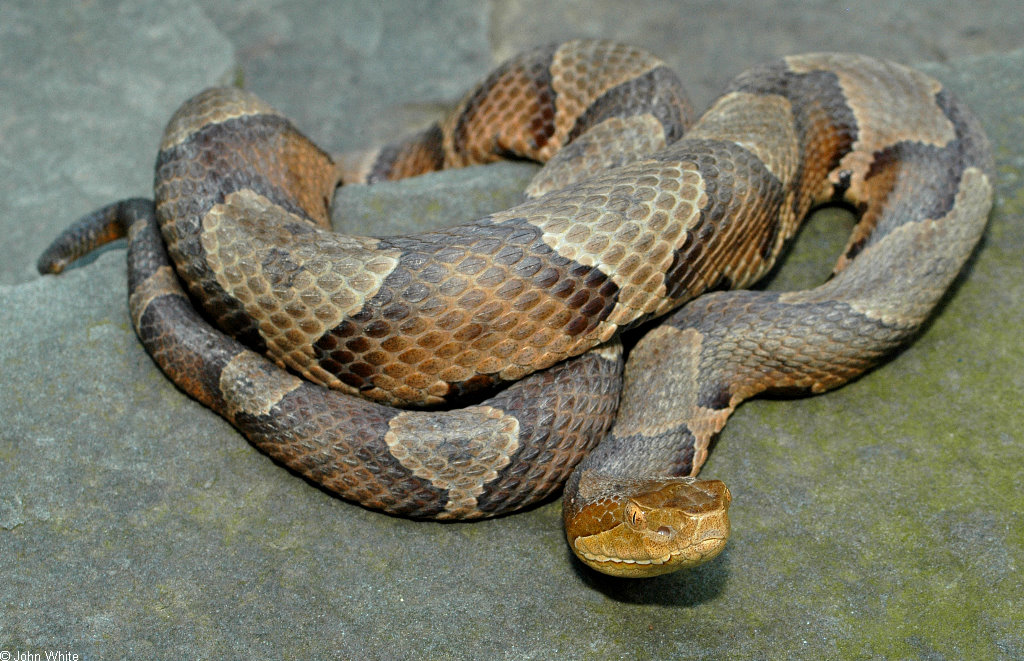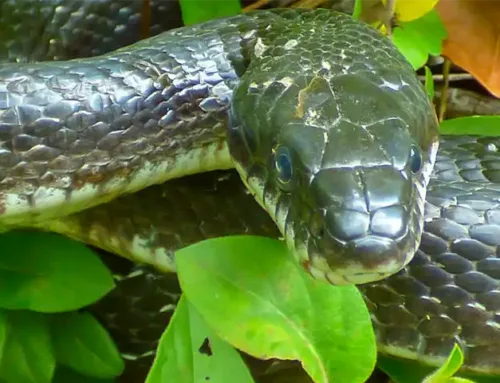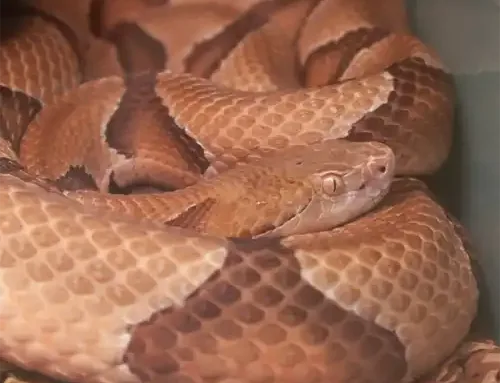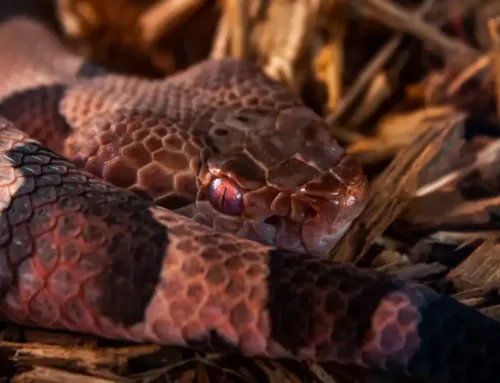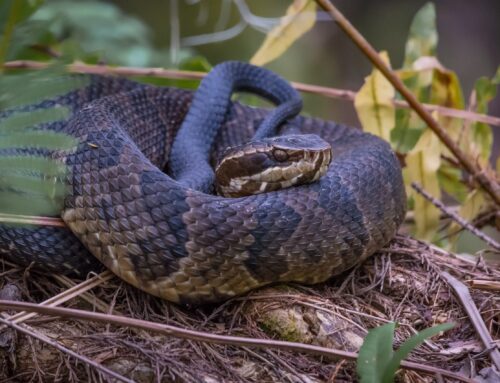Copperhead snake facts: Copperheads are among the most common venomous snakes in America. Here’s everything you need to know about Copperheads
Copperhead snakes are among the most common snakes in North America. They’re also the most likely to bite, despite the fact that their venom is weak and bites are rarely harmful to people. An estimated 2,920 people are bitten by copperheads annually in the United States. The incidence of bites by these venomous snakes is 16.4 per million population per year. However, the case-fatality rate is exceedingly low, at about 0.01%.
Copperheads, like rattlesnakes and water moccasins, are pit vipers. Pit vipers feature heat-sensory pits between the eye and nostril on either side of the head, which can detect minute temperature variations and allow the snakes to strike the source of heat, which is often possible prey. The behavior of copperheads is remarkably similar to that of most other pit vipers. If you want more detailed information on Copperheads go to this link
COPPERHEAD IDENTIFICATION
Copperheads are medium-sized snakes that range in length from 2 to 3 feet (0.6 to 0.9 meters). Female copperheads are longer than males, according to the Smithsonian National Zoological Park, although males have proportionally longer tails.
Copperheads have different patterns on their bodies. On a lighter brown, tan, salmon, or pinkish backdrop, they have a series of dark, chestnut-brown, or reddish-brown crossbands, each shaped like an hourglass, dumbbell, or saddlebag. These saddlebag-style marks are wide on the sides of the body and narrow in the center. Darker edges and lighter lateral centers are common in crossbands. Some crossbands may be fractured, and little black patches may be present in the gaps between them.
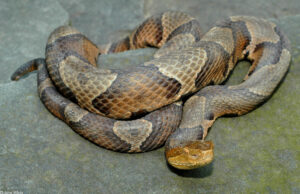
Eastern Copperhead (found in Virginia)
Many nonvenomous snakes have similar coloring to copperheads and are commonly mistaken for them. Copperheads, on the other hand, are the only snakes with hourglass-shaped patterns.
The snake’s coppery-brown head, in contrast to its patterned body, is devoid of such embellishments, save for a couple of tiny black spots on top. Copperheads have large bellies that are whitish, yellowish, or light brownish, stippled or mottled, with brown, gray, or blackish blotches or smudges down the sides of their belly.
Copperheads have broad, muscular bodies with ridged scales. Their heads are bowed with a noticeable ridge dividing the top of the head from the side snout between the eye and nostril, it is slightly triangular/arrow-shaped and separate from the neck. Their pupils are vertical, similar to a cat’s, and their irises are often orange, tan, or reddish-brown.
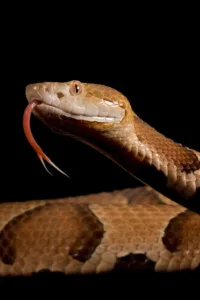
Young copperheads are grayer in color than adults and have bright yellow or greenish-yellow tail tips, which fade after roughly a year.
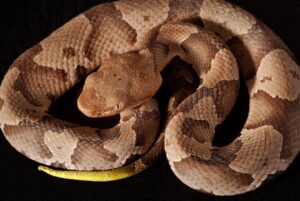
Young Copperhead Snake
HABITAT OF THE COPPERHEAD
Copperheads can be found throughout the United States, from southern New England through Virginia, West Texas, and northern Mexico. Asexual reproduction has been observed in female copperhead snakes.
Copperheads are divided into five subspecies based on their geographic range: northern, northwestern, southern, and two southwestern subspecies. The northern copperhead, according to the Smithsonian National Zoological Park, has by far the widest range, ranging from Alabama to Massachusetts and Illinois.
Copperheads may live in a broad variety of environments, though they like to be near woods or forests. They prefer rocky, wooded places, mountains, dense undergrowth near streams, desert oases, canyons, and other natural settings. They like habitats that provide both sunlight and cover.
Copperheads are quite adaptable to changes in their environment. This means they can thrive in suburban settings. Copperheads have been spotted in wood and sawdust heaps, abandoned agricultural buildings, junkyards, and construction sites. They frequently seek cover from the elements, such as boards, sheet metal, logs, or huge flat rocks.
BEHAVIOR OF COPPERHEADS
Snakes like copperheads are semi-social. While they normally hunt alone, they hibernate in communal dens and frequently return year after year. Timber rattlesnakes, rat snakes, and other species commonly hibernate in forest areas below timberline with huge, coniferous trees during the winter. Individual hibernation is more common in Piedmont and Coastal Plain snakes. They can also be observed close one other while sunbathing, drinking, eating, and courting.
Copperheads are most active during the day in the spring and fall, but they become nocturnal in the summer. They prefer to be outside on humid, warm nights following rain. Copperheads, who prefer to stay on the ground, will occasionally climb into low bushes or trees in pursuit of prey or to sunbathe in the sun. They even swim voluntarily on occasion.
Copperheads are thought to migrate late in the spring to their summer feeding grounds, then return home in the early fall.
COPPERHEAD DIET
Copperheads are hunter-gatherers. They mostly get their prey by ambush, but they do hunt occasionally, using their heat-sensing pits to locate prey.
Copperheads bite and then release their victims when they assault huge animals. They wait for the poison to take effect before tracking down the prey. Smaller prey is frequently held in the snake’s mouth until the victim dies. Copperheads devour their food whole, swallowing it with their flexibly hinged jaws. Adult copperheads may eat only 10 or 12 meals per year, depending on the size of their supper, according to Penn State.
REPRODUCTION OF THE COPPERHEAD SNAKE
Copperhead mating season is from February to May and late August to October, and it may be rather dramatic. When two or more males meet in the presence of a receptive female, they may fight. Losing snakes are rarely challenged again. A female may also fight potential partners, and males who refuse to fight her will be rejected.
Copperheads are ovoviviparous, meaning their eggs are incubated within the mother’s body. Live babies are born. Females give birth to two to 18 live offspring in late summer or fall after mating in the spring. The female will store sperm and defer conception for months after mating in the fall, according to The Maryland Zoo. According to the Smithsonian Zoo, baby copperheads are born with venom as strong as an adult’s. Young copperheads are 8 to 10 inches long and are born with fangs and venom. They usually eat insects, particularly caterpillars.
Adult copperheads may have distinct hunting tendencies than young copperheads. Caudal luring occurs when young snakes sit immobile while flicking their yellow tail tips. The tail mimics a little caterpillar or other insect, which may entice a lizard or frog to approach.
COPPERHEAD BITES
According to the North Carolina State University Cooperative Extension Service, copperheads bite more humans than any other snake species in the United States in most years. Copperhead venom is not particularly strong, fortunately.
Copperheads, unlike most venomous snakes, have no warning indications and strike quickly if they feel threatened. Their hemotoxic venom, which means that a bite from one causes transient tissue damage in the location of the bite. Their bite is painful, but it is seldom lethal to humans, especially if treated promptly. Children, the elderly, and those with weakened immune systems may have severe reactions to the venom, therefore anyone bitten by a copperhead should seek medical help.
COPPERHEAD SNAKE IN YOUR BACKYARD
Although many herpetologists believe that Copperhead snakes are beneficial to the ecology, many homeowners are less enthusiastic about having a snake in their backyard. If you come across a copperhead snake coiled up, they’ll normally stay perfectly quiet and hope you don’t notice them. It’s better to keep your distance and avoid bothering the snake, or hire a snake removal professional. If you startle them, they may try to flee, but they could also attack. It is always best to be cautious and keep your distance.
While there are advantages to having snakes, even a Copperhead, near your home (they eat disease-causing rodents like mice and rats), we understand your desire to keep your yard and home snake-free. For quick and safe snake removal, contact our snake removal experts today!
